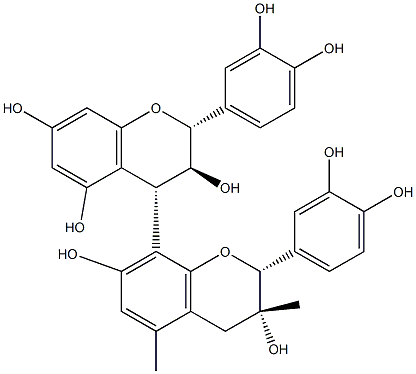Birch leaves extract
- CAS NO.:84012-15-7
- Molecular Weight: 0
- MDL number: MFCD05618071
- EINECS: 281-660-9
- Update Date: 2024-06-11 18:14:38
What is Birch leaves extract?
Absorption
For oleogel-S10 (Filsuvez, a preparation of birch bark extract), drug absorption was evaluated by measuring the systemic exposure to betulin, its main component. Betulin venous blood concentrations were measured using a dried blood spot bioanalytical method. In most subjects, betulin levels were below the quantitation limit (10 ng/mL). A minority of subjects had higher venous blood concentrations, no greater than 207 ng/mL. This venous blood concentration is similar to the one detected after ingesting betulin-containing foods.
Toxicity
Overdose cases involving topical birch bark extract are unlikely. No overdose cases have been reported using a maximum amount of 69 g daily for more than 90 days. Toxicity information regarding the accidental ingestion of birch bark extract gel is not readily available. Patients experiencing an overdose should receive symptomatic and supportive measures.
The Uses of Birch leaves extract
Birch leaves extract is believed to have antiseptic and astringent properties and to help heal skin irritations. It is used in traditional medicine for skin rashes. The leaves, which have a peculiar, aromatic, yet agreeable odor and a bitter taste, secrete a resinous substance with acid properties. They contain flavonoids, tannins, and essential oils.
Indications
Filsuvez, a preparation of birch bark extract, is indicated for the treatment of partial thickness wounds associated with dystrophic and junctional epidermolysis bullosa (EB) in patients 6 months and older.
Background
Birch bark extract is rich in triterpenoids with beneficial biological and pharmacological activities. Some of the compounds identified in it include betulin, lupeol, betulinic acid, oleanolic acid, and erythrodiol. Birch bark extract is obtained from the white part of the birch tree bark, and the main species of trees used for production are Betula pendula Roth (silver birch) and Betula pubescens Ehrh. (white birch), although hybrids of both species are used as well. Two oleogel formulations of birch bark extract (Oleogel-S10, 10% of triterpene dry extract in sunflower oil) have been approved by the European Medicines Agency. Filsuvez, one of these two formulations, is approved for the treatment of partial thickness wounds in patients with epidermolysis bullosa (EB), a rare group of hereditary disorders of the skin, mucous membranes, and internal epithelial linings characterized by extreme skin fragility and blister development. The EMA marketing authorization for Episalvan was withdrawn by the manufacturer in 2022.
Pharmacokinetics
Birch bark extract and its main component, betulin, promote wound healing and closure by activating pathways involved in keratinocyte differentiation and migration. Compared to a blinded control gel consisting of refined sunflower oil, beeswax, yellow wax and carnauba wax, Filsuvez (Oleogel-S10, a birch bark extract gel) promotes wound closure in patients with epidermolysis bullosa (EB). This effect was more noticeable in patients with recessive dystrophic EB than in patients with junctional EB (JEB) or dominant dystrophic EB (DDEB). Clinical data supporting the use of Filsuvez in patients with JEB or DDEB is insufficient; therefore, their condition should be evaluated regularly to assess the benefit of continued treatment. Birch bark extract may cause hypersensitivity, and theoretically, an increased risk of skin malignancies associated with the use of Filsuvez cannot be ruled out. Although birch bark extract gel is sterile, wound infection may occur during wound healing.
Metabolism
Approximately 99% of betulin, one of the main active components of birch bark extract, is metabolized in vitro within 5 hours. The most abundant betulin metabolite was formed through oxidation, methylation, and sulfation, and three other metabolites were formed by sulfation or glucuronidation. Betulin is expected to be metabolized mainly by non-CYP enzymatic pathways (75%). Betulin metabolism by CYP-mediated pathways (25%) is expected to be primarily performed by CYP3A4 and CYP3A5. In vitro studies have shown that betulin induces and inhibits several CYP enzymes; however, birch bark extract administered topically leads to negligible systemic exposure and no drug interaction is expected.
Safety information for Birch leaves extract
Birch leaves extract manufacturer
New Products
(S)-3-Aminobutanenitrile hydrochloride 4-Methylphenylacetic acid N-Boc-D-alaninol N-BOC-D/L-ALANINOL Tert-butyl bis(2-chloroethyl)carbamate N-octanoyl benzotriazole 3-Morpholino-1-(4-nitrophenyl)-5,6-dihydropyridin- 2(1H)-one Furan-2,5-Dicarboxylic Acid S-2-CHLORO PROPIONIC ACID ETHYL ISOCYANOACETATE 2-Bromo-1,3-Bis(Dimethylamino)Trimethinium Hexafluorophosphate 4-IODO BENZOIC ACID 3-NITRO-2-METHYL ANILINE 1-(2,4-DICHLOROPHENYL) ETHANAMINE (2-Hydroxyphenyl)acetonitrile 4-Bromopyrazole 5,6-Dimethoxyindanone 2-(Cyanocyclohexyl)acetic acid 4-methoxy-3,5-dinitropyridine 1-(4-(aminomethyl)benzyl)urea hydrochloride 2-aminopropyl benzoate hydrochloride diethyl 2-(2-((tertbutoxycarbonyl)amino) ethyl)malonate tert-butyl 4- (ureidomethyl)benzylcarbamate Ethyl-2-chloro((4-methoxyphenyl)hydrazono)acetateRelated products of tetrahydrofuran








You may like
-
 2033-24-1 98%View Details
2033-24-1 98%View Details
2033-24-1 -
 42831-50-5 5-METHYLISOXAZOLE-4-CARBOXYLIC ACID 98%View Details
42831-50-5 5-METHYLISOXAZOLE-4-CARBOXYLIC ACID 98%View Details
42831-50-5 -
 1975-50-4 98%View Details
1975-50-4 98%View Details
1975-50-4 -
 2-HYDROXY BENZYL ALCOHOL 98%View Details
2-HYDROXY BENZYL ALCOHOL 98%View Details
90-01-7 -
 2-Chloro-1,3-Bis(Dimethylamino)Trimethinium Hexafluorophosphate 221615-75-4 98%View Details
2-Chloro-1,3-Bis(Dimethylamino)Trimethinium Hexafluorophosphate 221615-75-4 98%View Details
221615-75-4 -
 61397-56-6 CIS BROMO BENZOATE 98%View Details
61397-56-6 CIS BROMO BENZOATE 98%View Details
61397-56-6 -
 14714-50-2 (2-Hydroxyphenyl)acetonitrile 98+View Details
14714-50-2 (2-Hydroxyphenyl)acetonitrile 98+View Details
14714-50-2 -
 118753-70-1 98+View Details
118753-70-1 98+View Details
118753-70-1